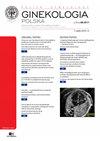Elabela levels in pregnancies with intrauterine growth retardation.
IF 1
4区 医学
Q3 OBSTETRICS & GYNECOLOGY
引用次数: 2
Abstract
OBJECTIVES The aim of our study is to examine maternal serum Elabela levels in pregnancy with intrauterine growth retardation (IUGR). IUGR is one of the most important causes of perinatal mortality and morbidity. IUGR is also related future comorobidities such as diabetes mellitus, hyperlipidemia, hypertension and coronary artery disease. MATERIAL AND METHODS Fifty pregnancies diagnosed as IUGR (Group 1) and fifty healthy pregnancies (Group 2) enrolled into the study. Obstetric and demographic characteristics of the patients, serum elabela levels, ultrasound parameters, cord pH value and APGAR scores of the newborns were recorded. In the study, which was planned as a prospective case-control study, an independent t test was used for the evaluation of continuous data and the Mann Whitney U test was used for the statistical evaluation of ordinal data. p < 0.05 was considered significant. RESULTS The mean gestational age of the cases at delivery was 36.35 ± 1.29 in Group 1 and 38.16 ± 0.94 weeks in Group 2 (p < 0.05). Mean serum Elabela levels were 15.05 ± 9.03 in Group 1 and 8.96 ± 4.33 ng/mL in Group 2 (p < 0.0001). Mean newborn weights were 2498.20 ± 465.92 in Group 1 and 3179.44 ± 387.99 gr. in Group 2 (p < 0.0001). Systolic and diastolic blood pressure measurements taken on the day of delivery were higher in Group 1, and diastolic blood pressure was 77.0 ± 9.53 in Group 1 and 72.60 ± 13.37 mmHg in Group 2 (p < 0.05). Bilateral uterine artery Pulsatile Index (PI) and umbilical artery PI value were significantly higher in Group 1 (p < 0.05), and middle cerebral artery PI and cerebroplacental ratio were significantly lower in Group 1 compared to Group 2 (p < 0.05). Although the cord pH value, 1st and 5th minute APGAR scores were lower in Group 1 compared to Group 2, no statistically significant difference was found (p > 0.05). CONLUSIONS In our study, it was found that serum Elabela levels increased significantly in pregnancies complicated by IUGR compared to the control group.宫内发育迟缓孕妇的Elabela水平。
目的:本研究的目的是检测宫内生长迟缓(IUGR)孕妇血清Elabela水平。IUGR是围产期死亡和发病的最重要原因之一。IUGR还与未来的合并症有关,如糖尿病、高脂血症、高血压和冠状动脉疾病。材料与方法:50例诊断为IUGR的孕妇(第一组)和50例健康孕妇(第二组)纳入研究。记录患者的产科和人口学特征、血清elabela水平、超声参数、脐带pH值和新生儿APGAR评分。本研究计划为前瞻性病例对照研究,对连续资料采用独立t检验,对有序资料采用Mann Whitney U检验进行统计评价。P < 0.05为差异有统计学意义。结果:组1平均胎龄36.35±1.29周,组2平均胎龄38.16±0.94周(p < 0.05)。血清Elabela水平1组为15.05±9.03 ng/mL, 2组为8.96±4.33 ng/mL (p < 0.0001)。1组新生儿平均体重为2498.20±465.92 g, 2组新生儿平均体重为3179.44±387.99 g (p < 0.0001)。组1分娩当日收缩压、舒张压增高,组1为77.0±9.53 mmHg,组2为72.60±13.37 mmHg (p < 0.05)。1组双侧子宫动脉搏动指数(PI)和脐动脉PI值显著高于2组(p < 0.05),大脑中动脉PI和脑胎盘比值显著低于2组(p < 0.05)。1组患儿脐带pH值、1、5分钟APGAR评分均低于2组,但差异无统计学意义(p > 0.05)。结论:本研究发现IUGR合并妊娠组血清Elabela水平明显高于对照组。
本文章由计算机程序翻译,如有差异,请以英文原文为准。
求助全文
约1分钟内获得全文
求助全文
来源期刊

Ginekologia polska
OBSTETRICS & GYNECOLOGY-
CiteScore
2.00
自引率
15.40%
发文量
317
审稿时长
4-8 weeks
期刊介绍:
Ginekologia Polska’ is a monthly medical journal published in Polish and English language.
‘Ginekologia Polska’ will accept submissions relating to any aspect of gynaecology, obstetrics and areas directly related. ‘Ginekologia Polska’ publishes original contributions, comparative works, case studies, letters to the editor and many other categories of articles.
 求助内容:
求助内容: 应助结果提醒方式:
应助结果提醒方式:


